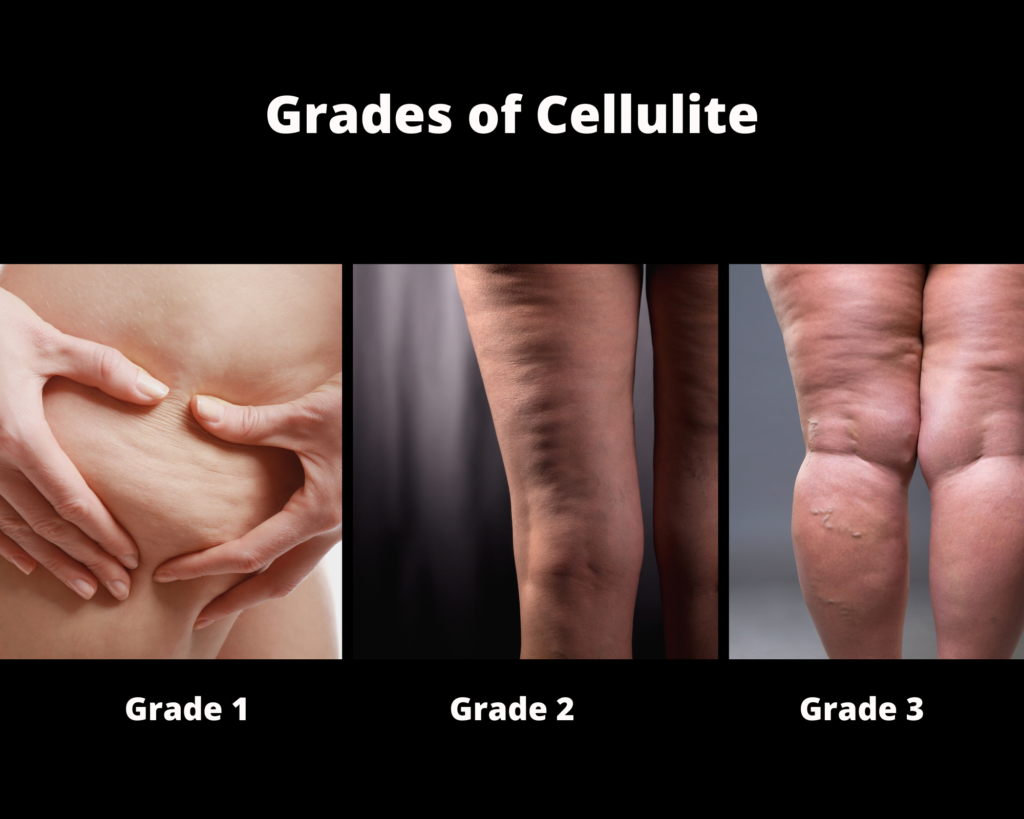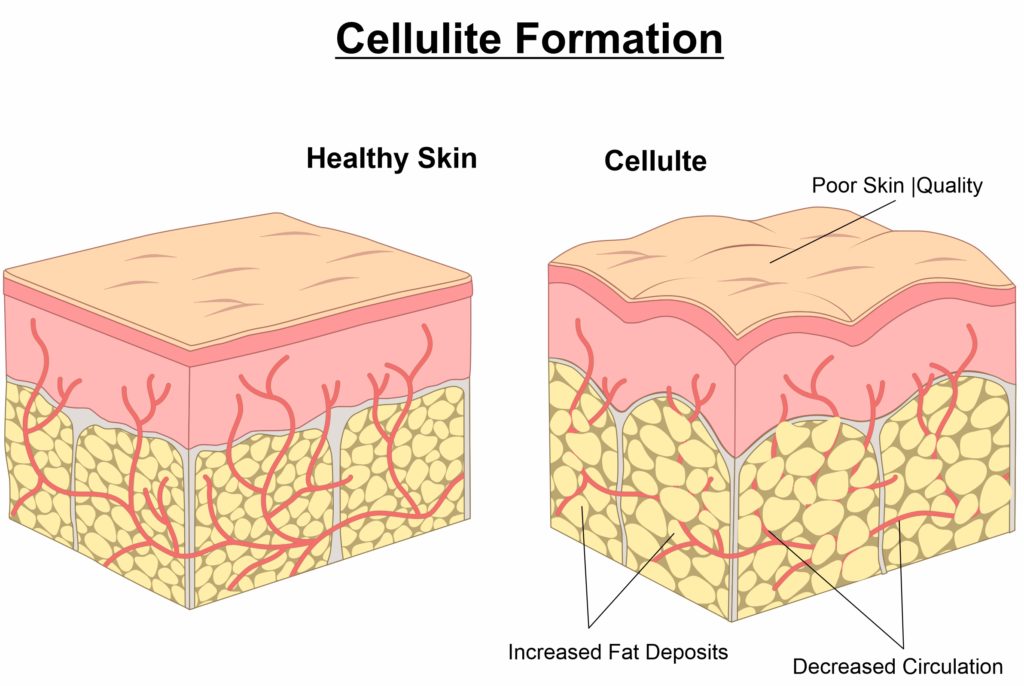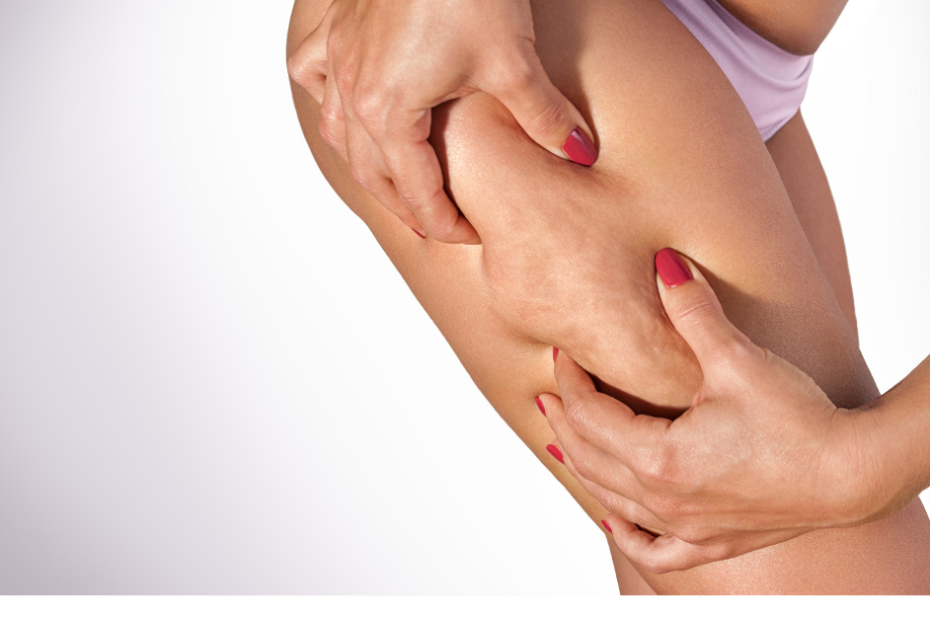What is body contouring?
Are you looking for cellulite treatments in Vancouver? You are not alone! Stubborn cellulite is one of the main complaints we hear from clients. We have been offering cellulite reduction treatments in Vancouver for years now and have developed a new approach to addressing this issue.
In this guide we talk about what cellulite is, some contributing factors, and our unique cellulite treatment offered in our Vancouver body contouring clinic.
What is cellulite?
If you are looking for cellulite treatments, you might be wandering what cellulite is. Is it fascia, fat, lymphatic retention or poor skin quality? There is so much conflicting information out there! In Vancouver you can find a wide range of cellulite treatments. Some target fat, some fascia, skin quality, or the lymphatic system, so choosing the right cellulite reduction approach can be confusing.
So what exactly is cellulite? The classic appearance of cellulite is mostly caused by fat, however it is also complicated by other issues such as skin laxity, genetics and lifestyle factors, making cellulite a very difficult condition to treat.
Also known as gynoid lipodystrophy, cellulite is a metabolic condition of the fat in our connective tissue layers that is seen in various degrees in most women and very rarely in men. It is more common in women due to the different distribution of fat, muscle, and connective tissue.
If you are struggling with cellulite and seeking cellulite treatment, you are not alone. About 80-90 percent of women may experience cellulite at some point in their lives. Cellulite can affect all body types since cellulite does not refer to fat, but to the “mattress” or dimpled, nodular and uneven appearance of the surface of the skin.
If you are frustrated with your cellulite, it might help you to know that your genetic makeup plays a big part. Did you know that in some areas of the body women have three layers of fat while men have one? That’s right, women have three layers of fat on the hips, buttocks, around the knees, the abdomen and triceps area, and this are exactly the areas where women tend to develop cellulite! In our Vancouver body sculpting clinic, we most often provide treatments for belly fat reduction, arm fat reduction, leg fat reduction and cellulite reduction, since these are the areas that women struggle with the most.
Does Cellulite Impact Health?
Why do so many women seek cellulite treatments and why should you treat your cellulite?
Cellulite is not pathological, however the presence of cellulite, especially grades 2 and 3, indicates degenerative processes affecting tissue health, such as fibrosis, inflammation, decreased microcirculation and skin laxity. Since cellulite indicates that your skin health is not optimal, it is a good idea to pursue cellulite treatments, since many of these treatments will also improve skin quality.
Although it does not represent a significant health hazard, cellulite may impact the psychosocial health of an individual and become an issue of importance for them. Since providing cellulite treatments in Vancouver we have heard from many clients that they find the appearance of their cellulite distressing. Many of our clients seek cellulite reduction treatments since their cellulite is preventing them from wearing the clothes they would like to, enjoying time at the beach in a bathing suit, or making them less confident in their intimate relationships.
Grade 2 or 3 cellulite may also be accompanied by pain in the affected areas. Cellulite treatments can improve both tissue heath and appearance, decrease pain, and prevent cellulite from getting worse with age.
In order to provide effective cellulite treatments, scientists have invested a lot of time and effort to completely understand all the factors surrounding cellulite, however there is still a lot of misinformation surrounding cellulite in the general public. We have experimented with a lot of different approaches to treating cellulite in our Vancouver body contouring clinic and have invested a lot of time in researching this condition in order to be able to best help our clients seeking cellulite treatments.
What Causes Cellulite?
Cellulite is hormonally and genetically influenced and in women it tends to appear (or worsen) during adolescence, pregnancy and menopause, or in the presence of factors such as hormonal birth control, prolonged sitting and a stressful lifestyle. Cellulite is mostly visible in the thighs, abdomen, buttocks and above the knees and is quite commonly seen in otherwise healthy women – it affects approximately 85% of the post-pubertal female population across all races. Interestingly, cellulite rarely affects men, however, if it occurs, it may be indicative of a lack of male hormones.
In order to comprehend the mechanism of cellulite development, some knowledge of basic skin anatomy is required. The superficial layer of the skin is called the epidermis. Beneath the epidermis lies the dermis, where most of the sweat glands, blood vessels and hair follicles are located. Beneath the dermis is a layer of subcutaneous fat. The small protrusions of subcutaneous fat that grow into the dermis represent the basic mechanism of cellulite development.
There is a hypothesis that the loss of skin elasticity allows the subcutaneous fat to protrude into the dermis, directly causing the appearance of cellulite. This would mean that degenerative tissue changes affecting the dermis are a factor in cellulite development. The alterations in the architecture of elastic fibers and the loss of collagen fibers in women increase the risk of cellulite development.

Are you finding that your cellulite is getting worse with age? There is a reason for this! As women advance in age, the decrease in estrogen negatively impacts blood vessels. This causes inflammation, decreased circulation and lymph drainage, proliferation of fibrous tissue, tissue degeneration and the protrusion of fat through layers of the skin, worsening the level of cellulite. In advanced cases, due to decreased microcirculation and lymphatic stagnation, the areas affected by cellulite can be cooler and feel more tender than the surrounding tissues.
What are some other factors contributing to cellulite?
Dehydration
If you don’t drink the recommended 8 to 10 glasses of water per day you are not alone! More than half of adults don’t drink enough water. Do you know that staying hydrated can help you prevent cellulite? Our body is composed of 60% water, which is why dehydration plays a big role in the formation of cellulite.
Not getting enough water can result in toxic build up in our fat cells, making them difficult for the body to metabolize, which can then contribute to the “cottage cheese” texture of cellulite. Being dehydrated also affects skin quality and causes our skin to become thinner and weaker. The weaker our skin is, the more tendency it has to show cellulite.
Overall, drinking more water and staying hydrated can aid with metabolizing fat, getting rid of toxins, as well as hiding cellulite via plumper skin.
Staying in a static position
Due to our modern lifestyle, we spend way too much of our day sitting. We sit in our cars, at our desk and on the couch at home. Sitting in the same position for a long time can affect the natural rhythm and flow of our circulatory system and in particular our lymphatic system. The circulatory pathways are rerouted to relieve stress, leading to the formation of varicosities. Varicose veins are a sign of altered circulatory routes due to static positions and a lack of movement. Lymphatic stagnation, especially if it occurs over the long term, also decreases tissue health, and contributes to a puffy appearance in the affected area. These factors increase the appearance of cellulite since affected areas have less blood supply, more stagnation and lower levels of hydration than normal tissue.
Inflammation
High levels of inflammation due to lifestyle factors such as smoking, drinking, stress, and unhealthy eating habits can play a factor in the worsening of cellulite. Research has found that cells associated with inflammation are present in cellulite affected tissue. Inflammation can cause tissues to appear more swollen, making cellulite more noticeable.
Types and Grades of Cellulite
Cellulite is not a simple issue as there are several types of cellulite that differ in morphology and the mechanism of development: soft, hard and edematous. These different types of cellulite present different challenges to treatment and can benefit from individualized approaches.
Types of Cellulite
Soft cellulite: This is also known as a flaccid cellulite. Soft cellulite is associated with sagging, loose skin and typically found on body areas where fat accumulates: stomach, arms, buttocks, abdomen and legs. Soft cellulite is not painful when we touch it, but the skin can feel gelatinous and undulating.
Hard cellulite: This compact, solid or hard cellulite is what causes the “orange peel” or “mattress” look. This type of cellulite can affect all women, including those who are slim and fit. It is characterised by depressions and on the thighs, buttocks and hips, and the skin may feel “stuck” or fibrotic. Sometimes, it can be painful to the touch and this pain is a sign that you should treat your cellulite as pain tends to get worse if left untreated.
Edematous cellulite: This is known as poor circulation cellulite and results from poor blood circulation that is aggravated by fluid retention. This is the least common form of cellulite and can be very challenging to treat. It can affect the thighs and knees, but most frequently the lower legs, which can sometimes change shape as they tend to swell. The skin tends to be painful when touched, or if you’re sitting for long periods of time.
Grades of cellulite

The severity and progression of cellulite is graded using the Nürnberger and Müller scale or the Cellulite Severity Scale.
Grade 1: This is what we call the “mild” stage. Dimpling, or an “orange peel” appearance is only visible when pressure is applied to the skin. This is when you should start treating your cellulite! Cellulite treatments have a good probability of working at this stage as tissue has not been yet severely compromised.
Grade 2: This is what we call the “moderate” stage. Grade 2 cellulite is apparent when standing but not so much when lying down. In this stage a “cottage cheese” or “mattress” appearance will start showing, small lumps, and bumps are visible and small areas of fibrosis might be detected. Tissue health is moderately compromised, with the area feeling either flaccid or fibrotic. The right cellulite treatment can still create significant improvements at this stage and halt progression to Grade 3.
Grade 3: This is what we call the “severe” stage. Dimpling is visible both when standing and when lying down and painful lumps may be felt under the skin. Blood and lymphatic flow to the area is severely impaired and tissue fibrosis has set it. Affected areas may feel cooler to the touch and edema might be present. This stage is most difficult to treat, more treatments are necessary and esthetic improvements are not as dramatic, but treatment is still advised in order to improve tissue health.
Our Approach Cellulite Treatment in our Vancouver Clinic
Are you looking for cellulite reduction in Vancouver? We invite you to give our LipoContour Cellulite Treatment a try.
We have been providing cellulite treatments in Vancouver for a while and have tested a variety of approaches. If you have tried improving the appearance of your cellulite you probably know that many cellulite treatments provide modest results.
In 2021 we have introduced our LipoContour Cellulite Treatment to our body contouring clinic in Vancouver and we have seen better results than with all other approaches we have tried so far.
As we discussed above, the appearance of cellulite is most commonly caused by fat and complicated by poor skin quality and compromised local circulation. Our cellulite treatment addresses all of these issues and has other benefits besides a reduction in the appearance of cellulite. Our cellulite reduction treatment also tightens skin, slims down the legs, reduces saddlebag fat and improves local circulation!
Our treatment is fully manual and involves the prolonged application of specific techniques to the affected areas. The purpose of our cellulite treatment is to produce an inflammatory process in the fat layer in order decrease the size of the fat cells and tighten skin. Typically, 1 to 3 sessions per treated area are sufficient for a noticeable reduction in cellulite, together with the additional benefits of slimming and skin tightening!
We are excited to be the first to introduce this cellulite reduction treatment to Vancouver and we believe that it is one of the best options for treating cellulite available at moment. We hope to see you soon in our Vancouver body contouring clinic for our cellulite treatment or other body or face treatments!
